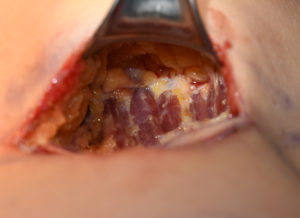Buttock implants have been used in aesthetic surgery for over forty years. But unlike breast implants, where extensive clinical data has been gathered and analyzed, the same can not be said for buttock implants. One of the most important issues for any implant in the body is pocket location. For buttock implants the two pocket locations primarily used today are above the muscle (subfascial) and in the muscle. (intramuscular) While those surgeons who regularly perform buttock implants have a good feel for their differences, it is of great relevance to know what their potential outcomes differences are.
In the Online First edition of one of the 2013 issues of the Aesthetic Plastic Surgery journal an article was published entitled ‘Surgical Pocket Location for Gluteal Implants: A Systematic Review’. In this paper the authors reviewed the medical literature of all articles published on buttock implants in plastic surgery journals from 1969 to 2012 of which thirty articles were found. The goal was to determine the outcomes from different pocket locations including acute and chronic complications such as wound dehiscences, wound infection, seroma, hematoma, implant asymmetry, and capsular contracture. This study conducted a systematic review to derive evidence-based recommendations concerning the safest type of pocket location including submuscular, subfascial, intramuscular, or the intramuscular XYZ method.
The results showed that the pocket locations for buttock implants that have the lowest complication rates are the intramuscular XZY method (13%), submuscular (18%), intramuscular (18%), and subfascial (55%).
The most common complications from buttock implant surgery were wound dehiscences (10%), seroma (2.5 %), wound infection (1.1 %), and hematoma (0.25 %). Satisfaction rates after surgery with the different pocket locations was not specifically studied and involved too many different types of implants and sizes to allow for any comparison between pocket locations.

The dilemma is, however, that pocket location also affects buttock implant size. You simply can’t put as big an implant in the intramuscular pocket as the subfascial one. And this poses a difficult aesthetic choice for many patients as well as one for the surgeon as well. On the hand the surgeon wants to please the patient and not have them undergo an operation after which they are not satisfied. Conversely, the surgeon also does not want the patient to suffer a complication that could potentially result in removal of the implants either.

Dr. Barry Eppley
Indianapolis, Indiana


